Magnetite-Modified Asphalt Pavements in Wireless Power Transfer: Enhancing Efficiency and Minimizing Power Loss Through Material Optimization
Abstract
1. Introduction
2. Materials and Methods
2.1. Raw Materials
2.2. Sample Preparation
2.3. Material Testing and Characterization Methods
2.4. Effective Permeability Model
3. WPT System for LCC-S Topology
3.1. Theoretical Analysis of the WPT System
3.2. Modeling of Coils and Pavement
3.3. WPT System Test
4. Results and Discussions
4.1. Morphological Characteristics of Magnetite
4.2. Coupling Coefficient and Transmission Efficiency
4.3. Thicknesses of Pavement Materials
4.4. Output Power and Power Loss
5. Conclusions
- Magnetite incorporation significantly improved magnetic coupling properties, with the coupling coefficient peaking at 0.242 at 10% content and efficiency reaching 84.67%. Beyond this threshold, efficiency declined due to escalating eddy current and hysteresis losses, defining 5–10% as the optimal magnetite dosage range. Incorporating magnetite significantly enhances coupling efficiency by improving permeability, evidenced by an increased magnetic flux density modulus in secondary coil gaps. In contrast, conventional asphalt (0% magnetite) exhibits air-core system characteristics with dispersed flux paths and poor coupling due to low-permeability media. These findings demonstrate that strategic magnetite integration effectively concentrates magnetic flux transmission, overcoming the limitations of air-dominated systems. The research prioritizes permeability enhancement through material modification as the key pathway for sustainable electromagnetic pavement system development.
- The critical thickness threshold for magnetite-modified asphalt pavements is identified as 50 mm. Below 50 mm, maximum and minimum magnetic field intensities exhibit strong negative correlations with thickness, while exceeding this threshold intensifies magnetic field non-uniformity in the coil near-field region, leading to significant energy dissipation. The coupling coefficient gain of magnetite-modified mixtures weakens markedly beyond 50 mm. Finite element simulations (error < 2%) validate the model accuracy. These findings provide critical guidance for balancing electromagnetic performance and structural feasibility in wireless charging pavements. Future work will refine multiphase composite models to optimize magnetic material distribution.
- The output power and power loss in the WPT system exhibited a nonlinear dependence on magnetite content. Output power increased with magnetite content, with the most rapid power gain at 10% content. The equivalent permeability of magnetite-modified asphalt mixtures increases with magnetite content, enhancing magnetic field intensity and output power in wireless power transfer systems. However, at 25% magnetite content, magnetic flux within the effective coupling region decreases, while the minimum flux density modulus rises significantly, indicating flux dispersion into non-effective regions. Concurrently, hysteresis and eddy current losses escalate substantially. These results identify 10% as the critical magnetite content threshold, highlighting the need for optimized material composition to balance electromagnetic efficiency and energy dissipation.
Author Contributions
Funding
Institutional Review Board Statement
Information Consent Statement
Data Availability Statement
Acknowledgments
Conflicts of Interest
Abbreviations
| WPT | wireless power transfer |
| FEM | finite element model |
| LCC | inductor–capacitor–capacitor |
| S | Series |
| EV | electric vehicle |
| ZPA | zero phase angle |
| SEM | scanning electron microscopy |
| EDS | energy-dispersive X-ray spectroscopy |
| VSM | vibrating sample magnetometry |
| LCR | inductance capacitance and resistance |
| k | coupling coefficient |
References
- Amjad, M.; Farooq-i-Azam, M.; Ni, Q.; Dong, M.X.; Ansari, E.A. Wireless charging systems for electric vehicles. Renew. Sustain. Energy Rev. 2022, 167, 112730. [Google Scholar] [CrossRef]
- Chen, F.; Taylor, N.; Kringos, N. Electrification of roads: Opportunities and challenges. Appl. Energy 2015, 150, 109–119. [Google Scholar] [CrossRef]
- Jang, Y.J. Survey of the operation and system study on wireless charging electric vehicle systems. Transp. Res. Part C-Emerg. Technol. 2018, 95, 844–866. [Google Scholar] [CrossRef]
- Lee, H.Y.; Im, S.H.; Park, G.S. Effects of Electro-Magnetic Properties of Obstacles in Magnetic Resonant Wireless Power Transfer. Energies 2021, 14, 7469. [Google Scholar] [CrossRef]
- Li, F.; Li, Y.; Zhou, S.; Chen, Y.; Sun, X.; Deng, Y. Wireless power transfer tuning model of electric vehicles with pavement materials as transmission media for energy conservation. Appl. Energy 2022, 323, 119631. [Google Scholar] [CrossRef]
- Chen, F.; Taylor, N.; Balieu, R.; Kringos, N. Dynamic application of the Inductive Power Transfer (IPT) systems in an electrified road: Dielectric power loss due to pavement materials. Constr. Build. Mater. 2017, 147, 9–16. [Google Scholar] [CrossRef]
- Zhai, Y.Y.; Zhong, Y.H.; Zhang, B.; Li, X.L. Investigating the sensitivity of mineral aggregate size on the dielectric response of asphalt concrete based on a multiscale experiment. Aip Adv. 2022, 12, 035314. [Google Scholar] [CrossRef]
- Li, Y.J.; Li, F.; Zhou, S.Q.; Ma, X.L.; Hou, Y. Development of soft magnetic composites for magnetized pavement to improve the efficiency of electric vehicle’s wireless power transfer. J. Clean. Prod. 2024, 459, 142446. [Google Scholar] [CrossRef]
- Venugopal, P.; Shekhar, A.; Visser, E.; Scheele, N.; Mouli, G.R.C.; Bauer, P.; Silvester, S. Roadway to self-healing highways with integrated wireless electric vehicle charging and sustainable energy harvesting technologies. Appl. Energy 2018, 212, 1226–1239. [Google Scholar] [CrossRef]
- Ceravolo, R.; Miraglia, G.; Surace, C. Fatigue damage assessment of electric roads based on probabilistic load models. J. Phys. Conf. Ser. 2017, 842, 012037. [Google Scholar]
- Li, J.; Wen, H.; Zhang, K.; Yan, Z.; Song, B.; Yang, L.; Tong, X. Research Progress on Electromagnetic Interference Suppression of Magnetically-coupled Wireless Power Transfer System. Proc. Chin. Soc. Electr. Eng. 2022, 42, 7387–7402. [Google Scholar]
- Guo, L.K.; Wang, H. A novel design of partially magnetized pavement for wireless power transfer to electric vehicles with improved efficiency and cost saving. Energy Convers. Manag. 2022, 252, 115080. [Google Scholar] [CrossRef]
- Mi, C.C.; Buja, G.; Choi, S.Y.; Rim, C.T. Modern Advances in Wireless Power Transfer Systems for Roadway Powered Electric Vehicles. IEEE Trans. Ind. Electron. 2016, 63, 6533–6545. [Google Scholar] [CrossRef]
- Iam, I.W.; Choi, C.K.; Lam, C.S.; Mak, P.I.; Martins, R.P. A Constant-Power and Optimal-Transfer-Efficiency Wireless Inductive Power Transfer Converter for Battery Charger. IEEE Trans. Ind. Electron. 2024, 71, 450–461. [Google Scholar] [CrossRef]
- National Standardization Administration of China. Electric Wireless Power Transfer—Part 3: Specific Requirements; National Standardization Administration of China: Beijing, China, 2020. [Google Scholar]
- Che, K.; Yang, P.; Luo, P.; Yu, J.X.; Hou, H.P.; Niu, X.N.; Gong, Y.Q.; Chen, C.M. Electromagnetic simulation and electromagnetic safety characteristics analysis of implantable medical devices in wireless charging processes. J. Comput. Methods Sci. Eng. 2024, 24, 2357–2374. [Google Scholar] [CrossRef]
- Pei, J.Z.; Guo, F.C.; Zhang, J.P.; Zhou, B.C.; Bi, Y.Q.; Li, R. Review and analysis of energy harvesting technologies in roadway transportation. J. Clean. Prod. 2021, 288, 125338. [Google Scholar] [CrossRef]
- Zhang, C.; Chen, M.Y.; He, Z.W.; Geng, J.G.; Wu, H.Z.; Li, Q.B.; Niu, Y.H. Performance analysis of thermally and non-conductive cement mortar prepared from waste iron scraps and magnetite sand. Int. J. Pavement Eng. 2024, 25, 2286455. [Google Scholar] [CrossRef]
- Liu, Q.T.; Yu, W.; Schlangen, E.; van Bochove, G. Unravelling porous asphalt concrete with induction heating. Constr. Build. Mater. 2014, 71, 152–157. [Google Scholar] [CrossRef]
- Elliott, R.J.; Krumhansl, J.A.; Leath, P.L. The theory and properties of randomly disordered crystals and related physical systems. Rev. Mod. Phys. 1974, 46, 465–543. [Google Scholar] [CrossRef]
- Giordano, S. Effective medium theory for dispersions of dielectric ellipsoids. J. Electrost. 2003, 58, 59–76. [Google Scholar] [CrossRef]
- Sihvola, A.H. Electromagnetic Mixing Formulas and Applications; Institution of Engineering and Technology: London, UK, 1999. [Google Scholar]
- Pahlavan, S.; Shooshtari, M.; Ashtiani, S.J. Star-Shaped Coils in the Transmitter Array for Receiver Rotation Tolerance in Free-Moving Wireless Power Transfer Applications. Energies 2022, 15, 8643. [Google Scholar] [CrossRef]
- Wang, H.P.; Zhang, Y.; Zhang, Y.; Feng, S.Y.; Lu, G.Y.; Cao, L.T. Laboratory and Numerical Investigation of Microwave Heating Properties of Asphalt Mixture. Materials 2019, 12, 146. [Google Scholar] [CrossRef]
- Lou, B.W.; Sha, A.M.; Barbieri, D.M.; Liu, Z.Z.; Zhang, F. Microwave heating properties of steel slag asphalt mixture using a coupled electromagnetic and heat transfer model. Constr. Build. Mater. 2021, 291, 10. [Google Scholar] [CrossRef]
- Miller, J.M.; Daga, A. Elements of Wireless Power Transfer Essential to High Power Charging of Heavy Duty Vehicles. IEEE Trans. Transp. Electrif. 2015, 1, 26–39. [Google Scholar] [CrossRef]
- Jonah, O.; Georgakopoulos, S.V. Wireless Power Transfer in Concrete via Strongly Coupled Magnetic Resonance. IEEE Trans. Antennas Propag. 2013, 61, 1378–1384. [Google Scholar] [CrossRef]
- Yang, Y.; Cui, J.L.; Cui, X. Design and Analysis of Magnetic Coils for Optimizing the Coupling Coefficient in an Electric Vehicle Wireless Power Transfer System. Energies 2020, 13, 4143. [Google Scholar] [CrossRef]

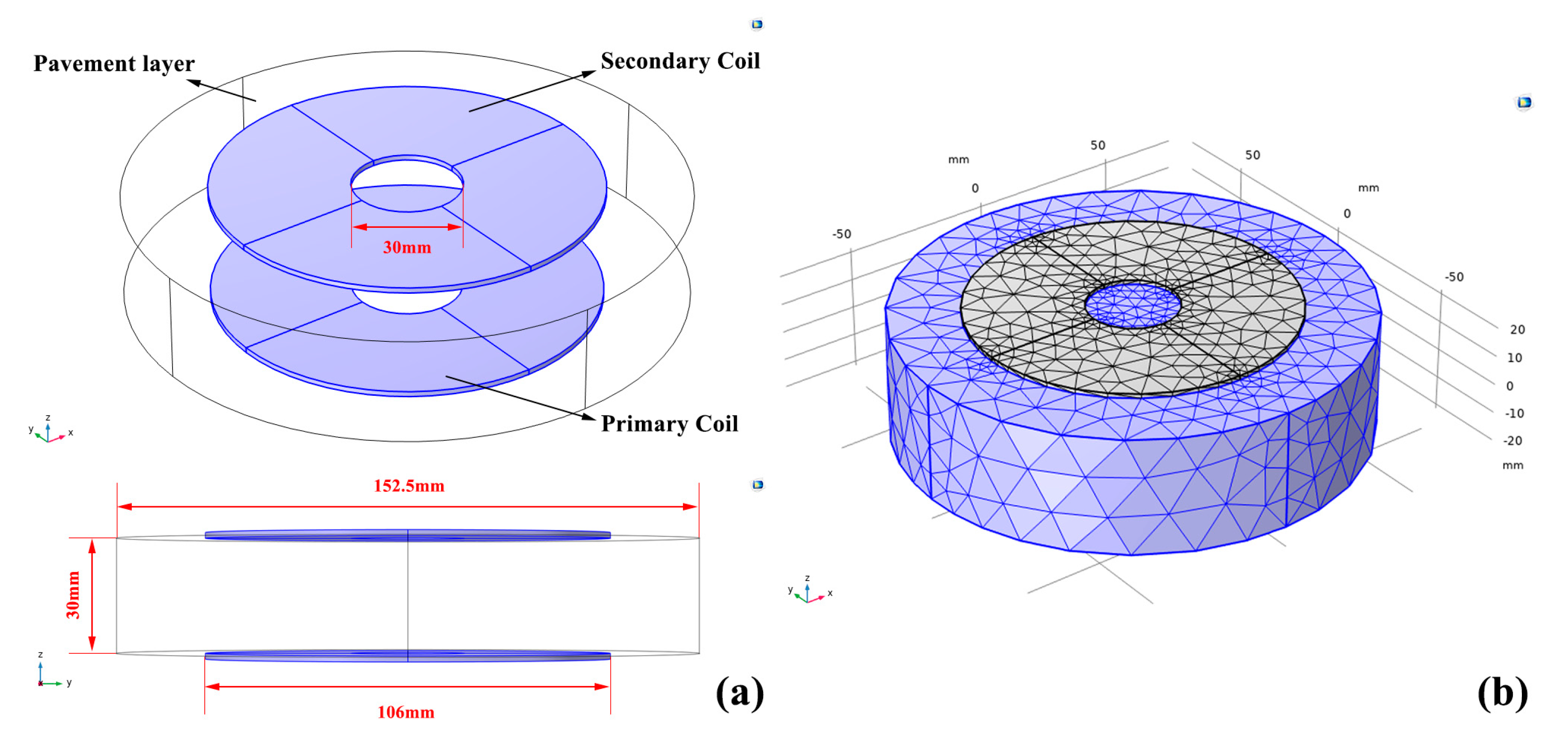
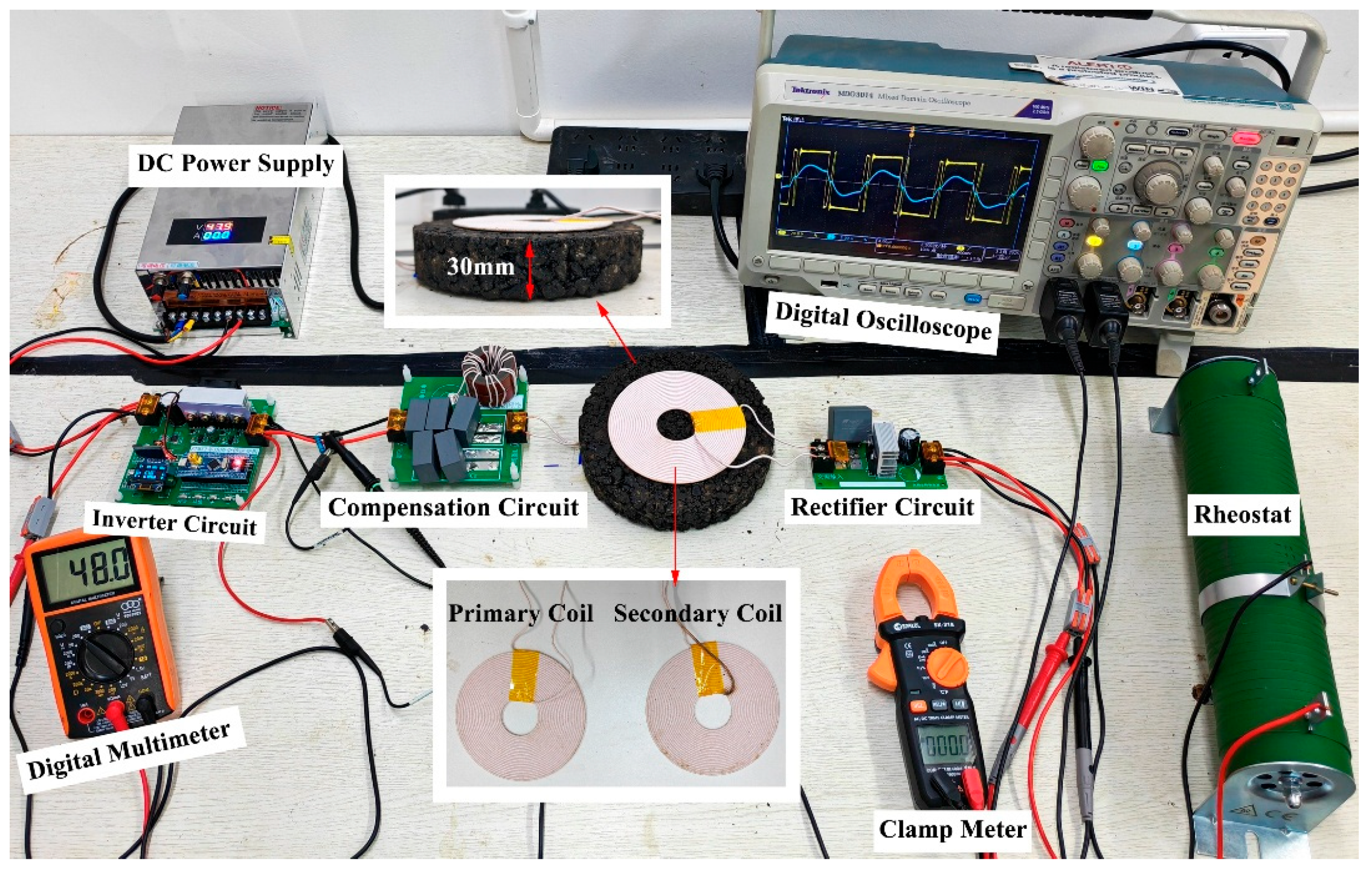
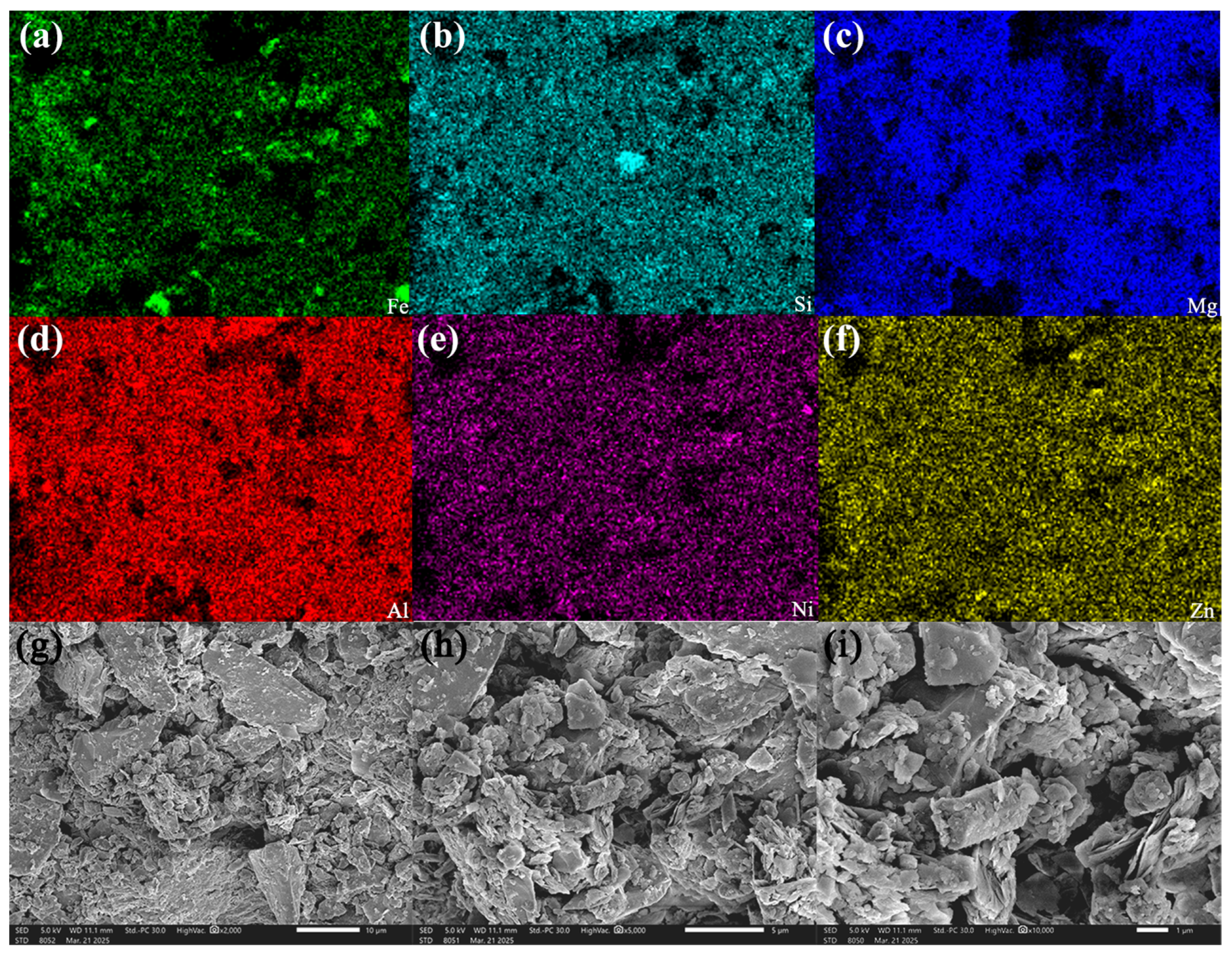
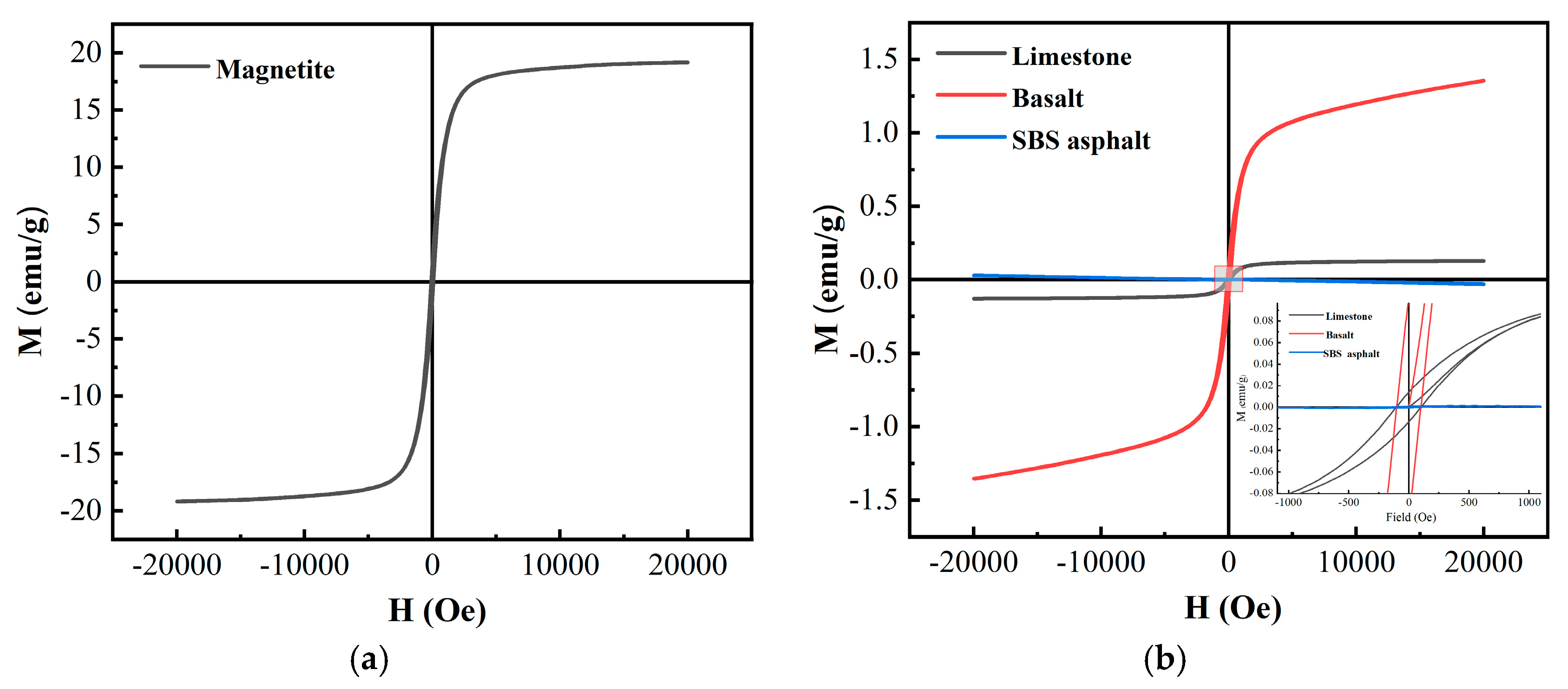
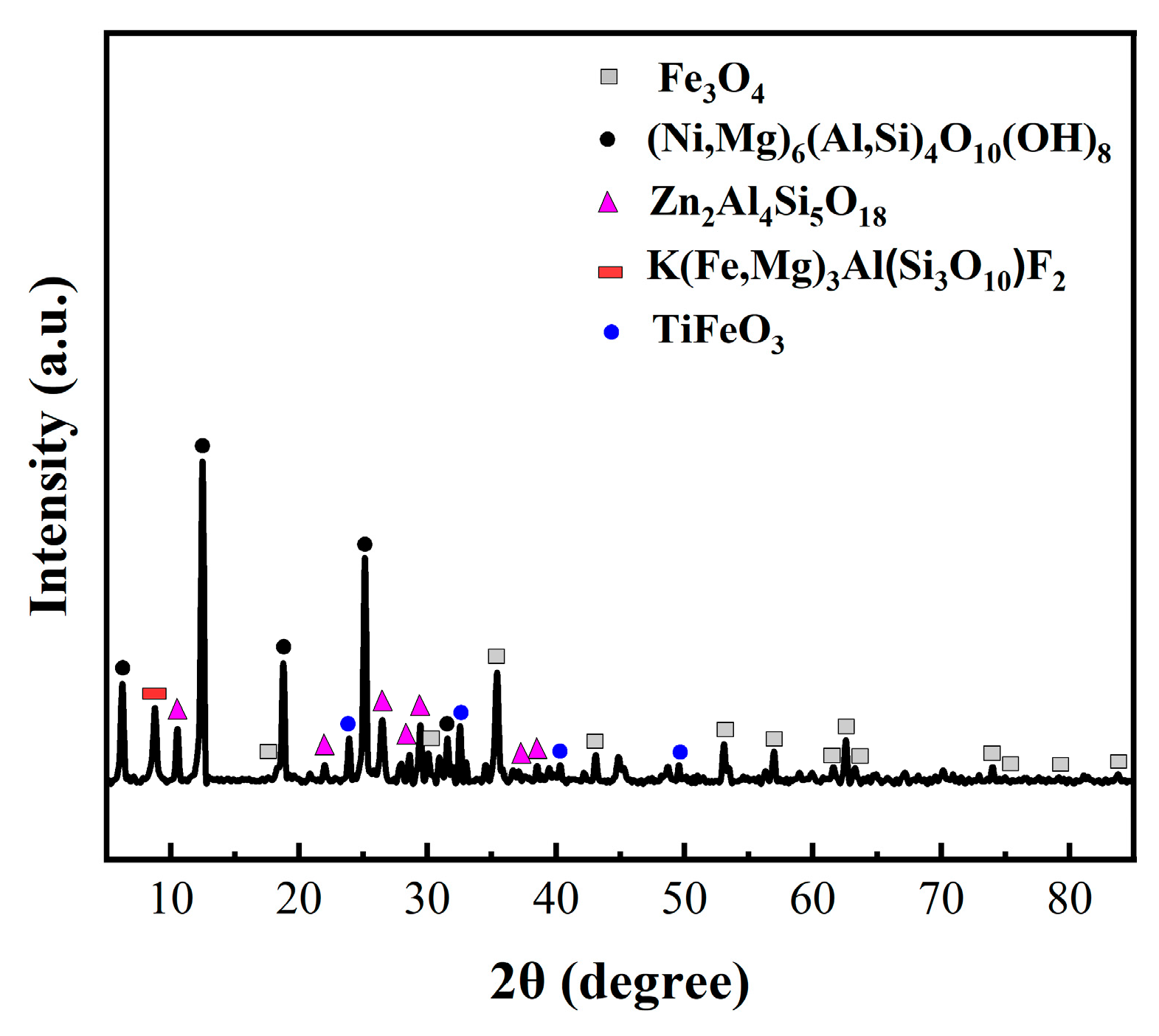
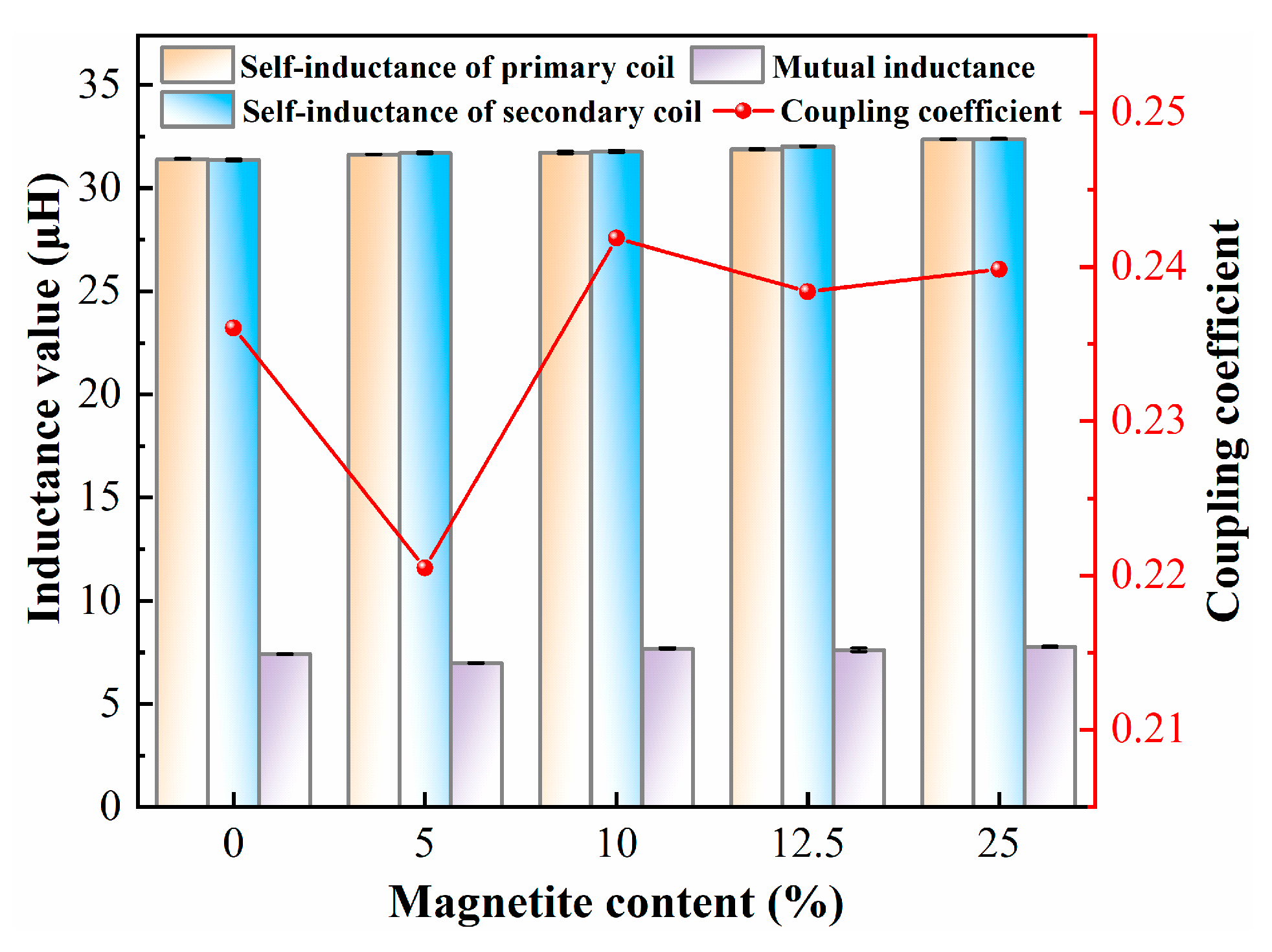
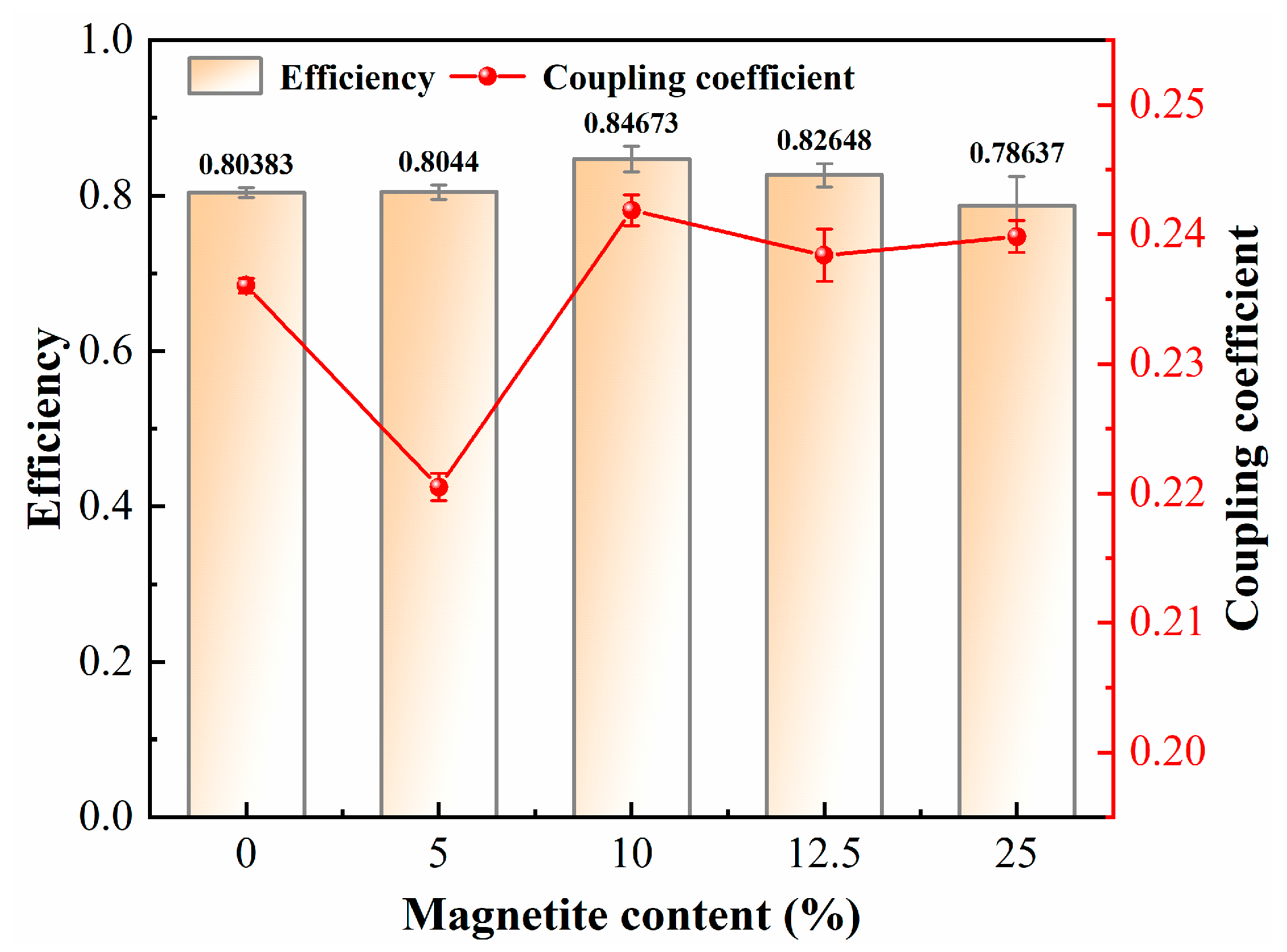
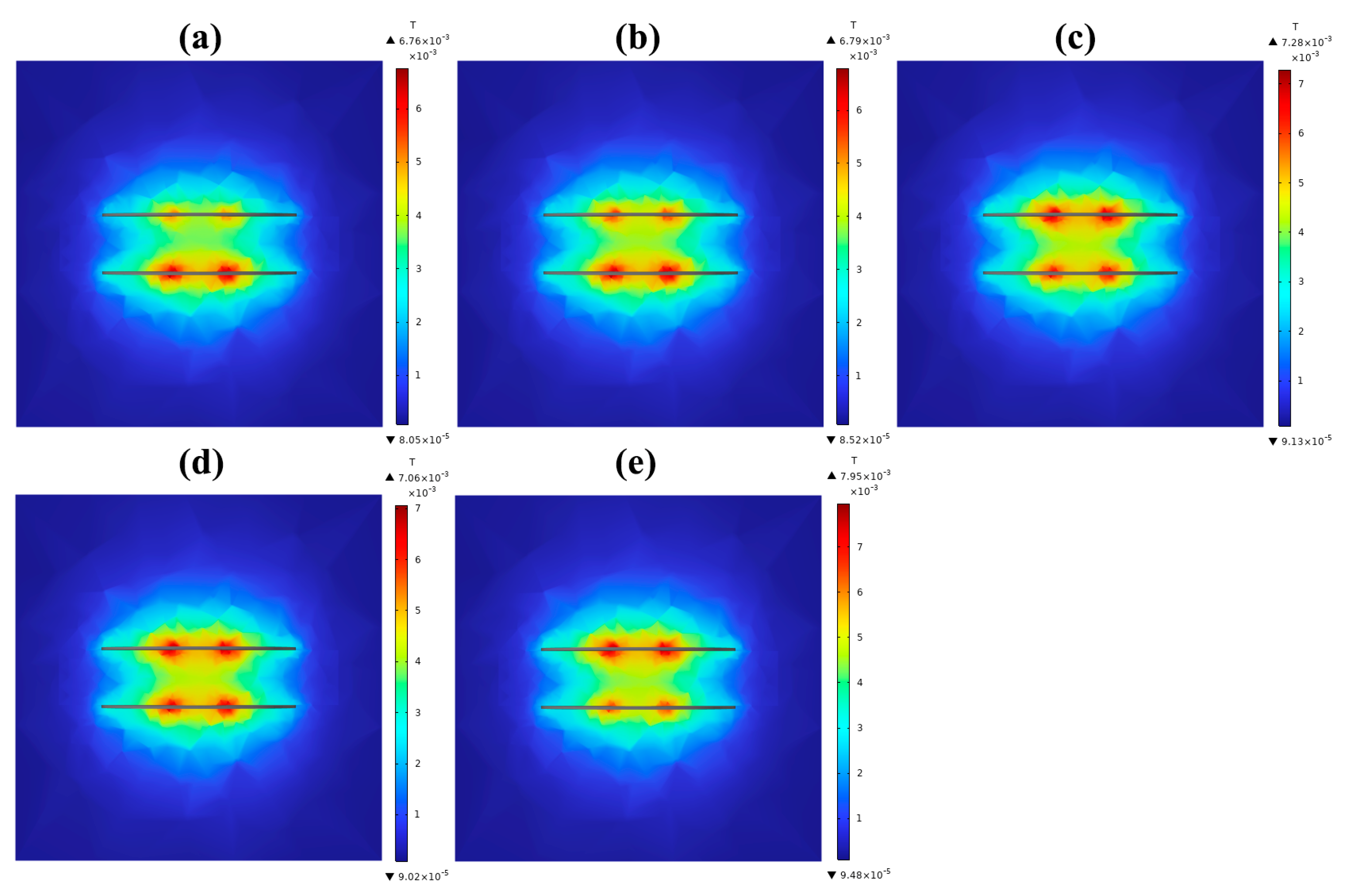
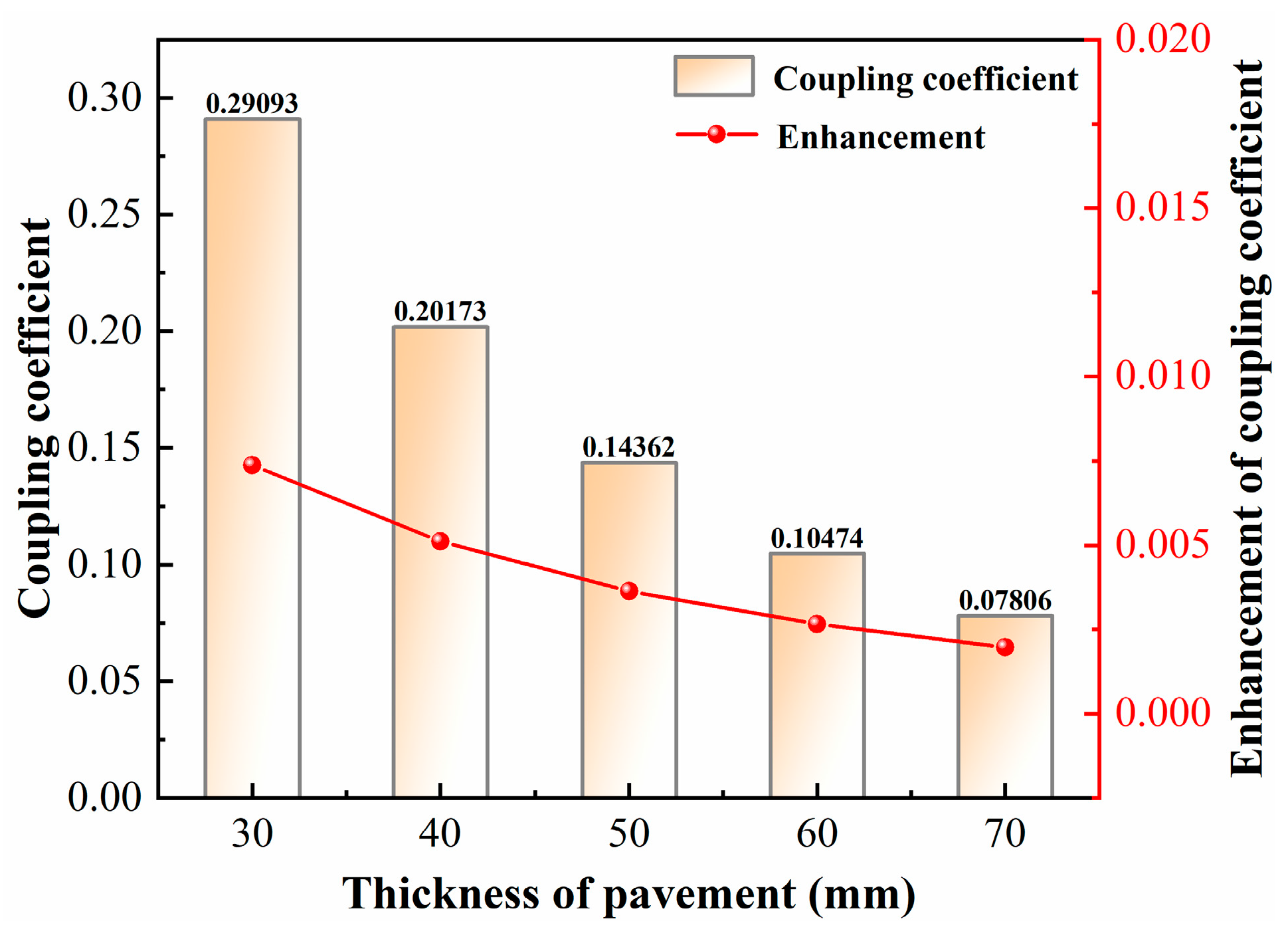

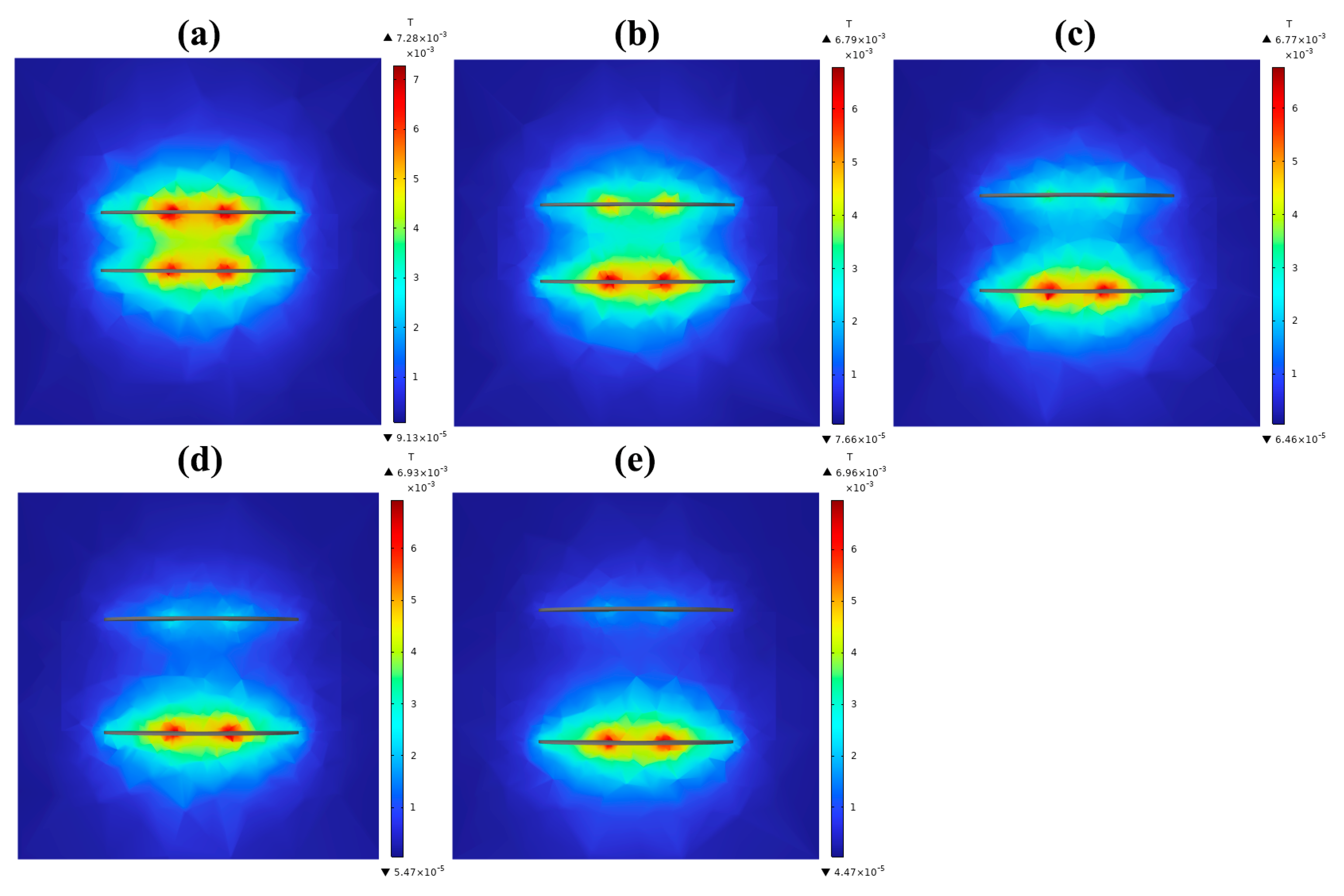
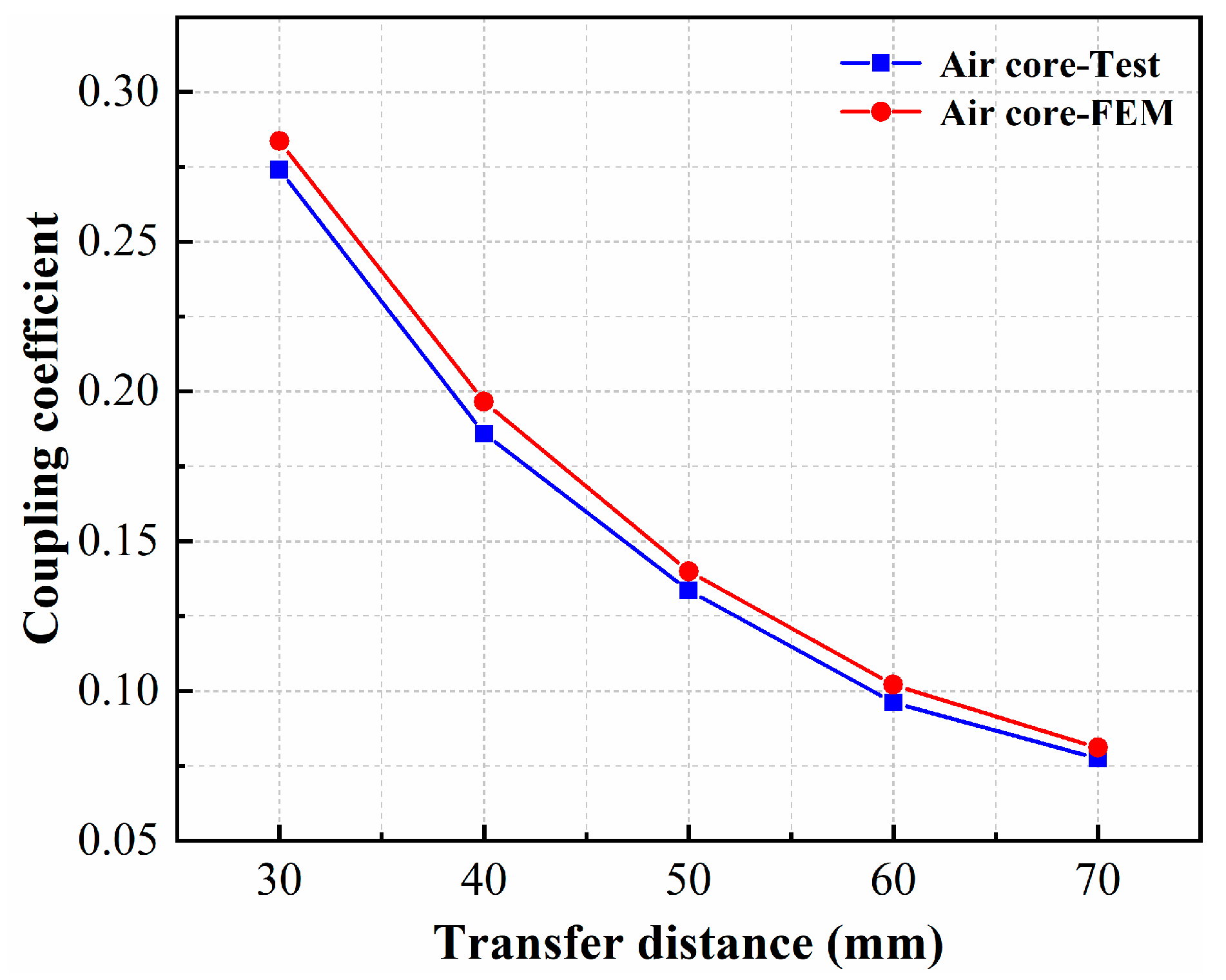

| Sieve Size (mm) | Passing Rate (%) |
|---|---|
| 13.2 | 97.8 |
| 9.5 | 74.7 |
| 4.75 | 47.4 |
| 2.36 | 33.9 |
| 1.18 | 25.9 |
| 0.6 | 19.1 |
| 0.3 | 11.8 |
| 0.15 | 8.2 |
| 0.075 | 6.7 |
| Property | Size (mm) | Bulk Density (g/cm3) | Los Angeles Abrasion Value (%) | Water Absorption (%) |
|---|---|---|---|---|
| Basalt | 4.75–13.2 | 2.757 | 22.7 | 1.61 |
| Magnetite | 4.75 | 4.331 | 20.792 | 0.863 |
| Limestone | 0.075–2.36 | 2.718 | - | 1.32 |
| Mixture Type | Bitumen (by Mass) | % of Addition 4.75 mm Particle Size (by Volume) | |
|---|---|---|---|
| Basalt | Magnetite | ||
| 1 | 4.7% | 100 | 0 |
| 2 | 95 | 5 | |
| 3 | 90 | 10 | |
| 4 | 87.5 | 12.5 | |
| 5 | 75 | 25 | |
| Udc (V) | ω (kHz) | Lin (μH) | Cf (nF) | Cp (nF) | Cs (nF) | RL (Ω) |
|---|---|---|---|---|---|---|
| 48 | 83.9 | 11.98 | 199.23 | 299.63 | 199.66 | 3.8 |
| Elements | Mg | Al | Si | Fe | Ni | Zn |
|---|---|---|---|---|---|---|
| Quality percentage (%) | 20.93 | 18.92 | 24.23 | 33.77 | 0.49 | 1.66 |
| Atomic number percentage (%) | 28.1 | 22.89 | 28.16 | 19.74 | 0.28 | 0.83 |
Disclaimer/Publisher’s Note: The statements, opinions and data contained in all publications are solely those of the individual author(s) and contributor(s) and not of MDPI and/or the editor(s). MDPI and/or the editor(s) disclaim responsibility for any injury to people or property resulting from any ideas, methods, instructions or products referred to in the content. |
© 2025 by the authors. Licensee MDPI, Basel, Switzerland. This article is an open access article distributed under the terms and conditions of the Creative Commons Attribution (CC BY) license (https://creativecommons.org/licenses/by/4.0/).
Share and Cite
Cui, X.; Sha, A.; Hu, L.; Liu, Z. Magnetite-Modified Asphalt Pavements in Wireless Power Transfer: Enhancing Efficiency and Minimizing Power Loss Through Material Optimization. Coatings 2025, 15, 593. https://doi.org/10.3390/coatings15050593
Cui X, Sha A, Hu L, Liu Z. Magnetite-Modified Asphalt Pavements in Wireless Power Transfer: Enhancing Efficiency and Minimizing Power Loss Through Material Optimization. Coatings. 2025; 15(5):593. https://doi.org/10.3390/coatings15050593
Chicago/Turabian StyleCui, Xin, Aimin Sha, Liqun Hu, and Zhuangzhuang Liu. 2025. "Magnetite-Modified Asphalt Pavements in Wireless Power Transfer: Enhancing Efficiency and Minimizing Power Loss Through Material Optimization" Coatings 15, no. 5: 593. https://doi.org/10.3390/coatings15050593
APA StyleCui, X., Sha, A., Hu, L., & Liu, Z. (2025). Magnetite-Modified Asphalt Pavements in Wireless Power Transfer: Enhancing Efficiency and Minimizing Power Loss Through Material Optimization. Coatings, 15(5), 593. https://doi.org/10.3390/coatings15050593







